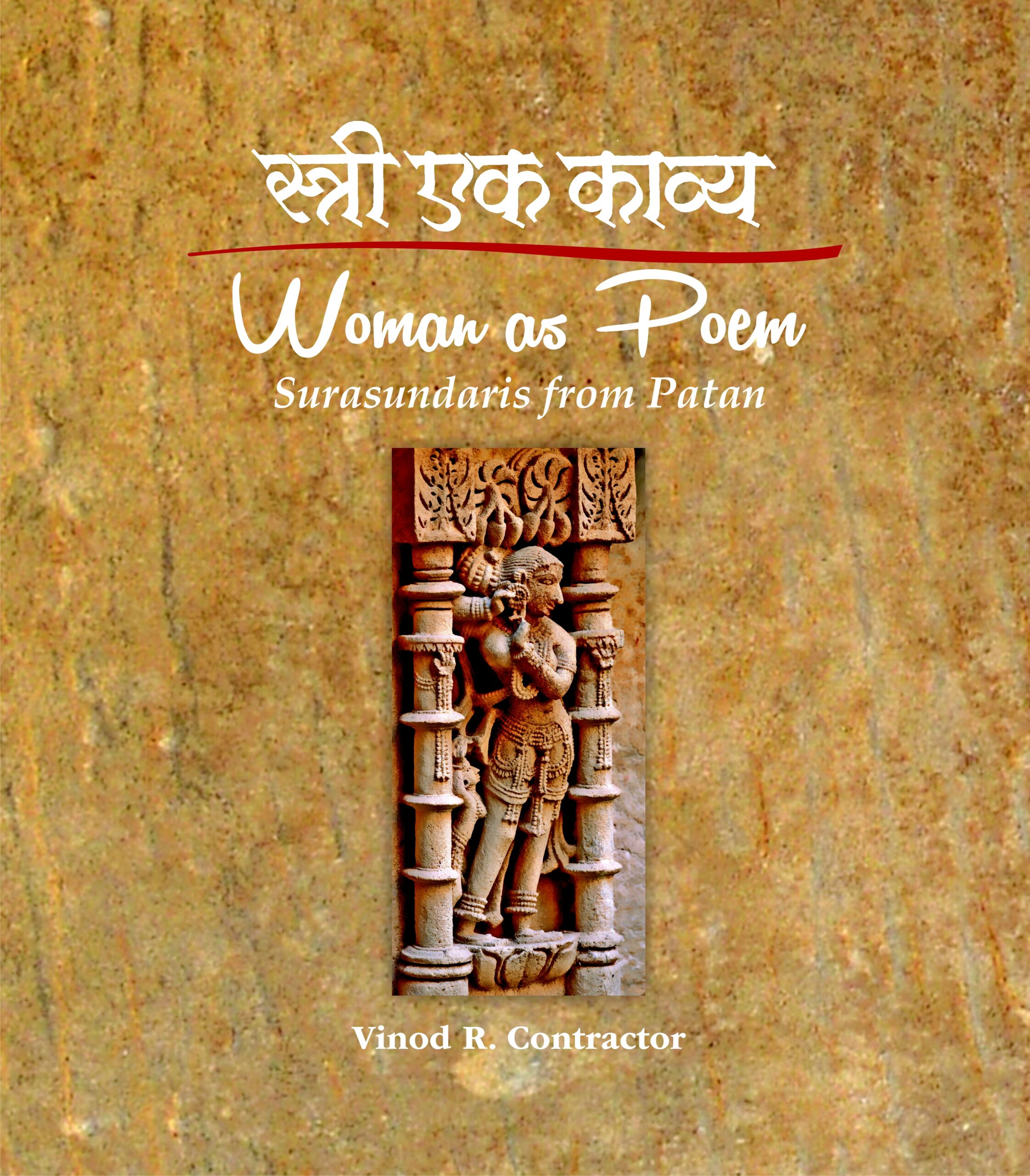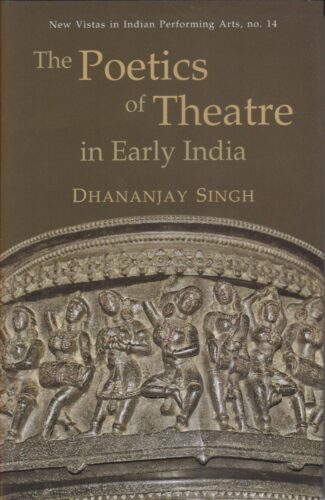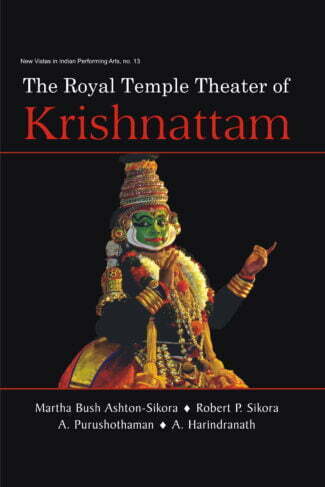Showing all 12 results
The book aspires to do for Indian poetics what Hudson’s book, An Introduction to the Study of English Literature did for English literature, though in a totally different manner and style. It provides the student with the essential knowledge about almost all aspects of Indian poetics. Based on the original Sanskrit sources, it presents the necessary information lucidly in precise and clear terms. Each chapter is self-contained and complete in itself, with explanatory notes, and a bibliography of relevant works. The Sanskrit terms used in the text are invariably explained or provided with English equivalents.
For quick reference, “A Glossary of Sanskrit Literary Terms” is given in the Appendices, which contain also “A List of Noted Indian Poeticians (including commentators) and Their Works” and “Notes on Major Texts in Indian Poetics”.
This handy volume, with its unique features, will prove invaluable to those who are going to embark on the study of Indian poetics, especially the ones who have no Sanskrit background. To a devoted student, it will prove a useful companion during his/her further studies.
The book aspires to do for Indian poetics what Hudson’s book, An Introduction to the Study of English Literature did for English literature, though in a totally different manner and style. It provides the student with the essential knowledge about almost all aspects of Indian poetics. Based on the original Sanskrit sources, it presents the necessary information lucidly in precise and clear terms. Each chapter is self-contained and complete in itself, with explanatory notes, and a bibliography of relevant works. The Sanskrit terms used in the text are invariably explained or provided with English equivalents.
For quick reference, “A Glossary of Sanskrit Literary Terms” is given in the Appendices, which contain also “A List of Noted Indian Poeticians (including commentators) and Their Works” and “Notes on Major Texts in Indian Poetics”.
This handy volume, with its unique features, will prove invaluable to those who are going to embark on the study of Indian poetics, especially the ones who have no Sanskrit background. To a devoted student, it will prove a useful companion during his/her further studies.
The centuries-old exchange of ideas, knowledge systems, resources, skills and materials among the people of the Asian continent left a lasting legacy in various spheres of human experience. This was a dialogue that involved rich exchange of religious, literary, aesthetic and artistic ideas and forms across the regions of Asia. The general impressions of an art, which is spiritual and magical in character, highly charged with literary myths and legends, and presented through a seemingly improvised styles in various art forms, provide us with a clue of an understanding of the fundamental foundations of the arts in Asia.
This volume contains the papers of the panel on ‘Asian Aesthetic Theories and Art Forms’ in first two sections. This panel was a part of the international conference on “Asian Encounters: Networks of Cultural Interaction” held in New Delhi. The volume reaffirms that the Indian theory of art as a creative process and creative expression is broadly true for entire Asian theory of art and aesthetics and it opens up a pan-Asian theory of art and aesthetics.
‘Representation of Asian Art in Asian Museums’ was another panel of the conference. The volume contains three papers from that panel also and the transcript of the dialogue held on ‘Cross Cultural Frontiers in the Study of the Past’.
Cinema Through Rasa discusses the important works of the world cinema in the light of Rasa Siddhānta of the Indian classical aesthetics. Rasa Siddhānta was first mentioned in Bharata Muni’s Nāṭyaśāstra – the ancient treatise on dramaturgy. This book catalogues the major cinematic works in the light of Abhinavabhāratī – a tenth-century commentary on the Nāṭyaśāstra by the great Kashmiri Śaivite philosopher Abhinavagupta. Further, it outlines the links between puruṣārtha, the cultural value system of life pursuits in Indian tradition, and aesthetics while citing examples from the works of major directors such as Orson Welles, Luis Buñuel, Ingmar Bergman, Akira Kurosawa, Andrei Tarkovsky, Alfred Hitchcock, Carl Dreyer, Charlie Chaplin, Sergei Eisenstein, Robert Bresson and Satyajit Ray.
Using contemporary scholars’ interpretation of non-dualistic Kashmir Śaivism tradition, Cinema Through Rasa aims to serve as a tribute to Abhinavagupta’s genius, a commentary on important ideas such as rasa, nature of emotions, cinema and beauty along with a tryst with the masterpieces of the world cinema. The meaning of this book is summarized by this verse – na hi rasād r̥te kaścid arthaḥ pravartate – the medium of cinema, though modern, should be seen as resting in the power of rasa without which nothing makes any sense.
This book is a translation of the original Hindi book Abhinava Cinema, which was first published in 2016. Abhinava Cinema was lauded as innovative, path-breaking and a must-read for students of literature and cinema studies by scholars and critics.
Cinema Through Rasa discusses the important works of the world cinema in the light of Rasa Siddhānta of the Indian classical aesthetics. Rasa Siddhānta was first mentioned in Bharata Muni’s Nāṭyaśāstra – the ancient treatise on dramaturgy. This book catalogues the major cinematic works in the light of Abhinavabhāratī – a tenth-century commentary on the Nāṭyaśāstra by the great Kashmiri Śaivite philosopher Abhinavagupta. Further, it outlines the links between puruṣārtha, the cultural value system of life pursuits in Indian tradition, and aesthetics while citing examples from the works of major directors such as Orson Welles, Luis Buñuel, Ingmar Bergman, Akira Kurosawa, Andrei Tarkovsky, Alfred Hitchcock, Carl Dreyer, Charlie Chaplin, Sergei Eisenstein, Robert Bresson and Satyajit Ray.
Using contemporary scholars’ interpretation of non-dualistic Kashmir Śaivism tradition, Cinema Through Rasa aims to serve as a tribute to Abhinavagupta’s genius, a commentary on important ideas such as rasa, nature of emotions, cinema and beauty along with a tryst with the masterpieces of the world cinema. The meaning of this book is summarized by this verse – na hi rasād r̥te kaścid arthaḥ pravartate – the medium of cinema, though modern, should be seen as resting in the power of rasa without which nothing makes any sense.
This book is a translation of the original Hindi book Abhinava Cinema, which was first published in 2016. Abhinava Cinema was lauded as innovative, path-breaking and a must-read for students of literature and cinema studies by scholars and critics.

A collection of fifteen scholarly articles, this volume talks about the development of convergences and divergences in Indian aesthetics under two broad topics – Theoretical Explorations and Applications – be it cinema, dance, drama, music, literature or sculpture.
A collection of fifteen scholarly articles, this volume focuses on the convergences and divergences which exist in Indian aesthetics, focusing both on Theoretical Explorations and their Applications. Indian aesthetics encompasses traditions and texts that focus on literary, visual, structural and performative productions of a wide range of art forms that delight, entertain, provoke their audience in ways that are relevant to the life. These art forms result in various responses such as delight, emotional relish, and enjoyment. In their convergence with other arts, different Indian art forms, be it cinema, dance, drama, music, literature or sculpture, have practised a “give and take” policy all through their history. Most of them are based on the rasa theory as the connecting thread. Talking about the divergences, the book details how different art forms emerged from a common root and shaped up as separate entities within the Indian framework, while embedding divergent viewpoints opening up the possibility of diverse views on the same concept. These developments also hold true for modern art forms like cinema. The volume provides illustrations taken from a wide range of art forms ancient and contemporary, talking about the diverse applications of Indian aesthetics across multiple art forms in recent times.

?????: ??????????????? ?? ?? ??????, ???? ??? ????? ?? ????? ?? ???? ??, ???? ??? ?? ?????? ????? ?? ???? ?? ???? ???? ?? ????? ???? ?? ?? ????? ???????? ?? ?????-???? ??, ??????? ????? ??????? ?????? ?? ???? ???? ???? ??, ??????? ?????? ??????? ??? ??? ?? – ?????? ??????? ?? ????? ?????? ???? ?????-??????? ??? ??? ???? ??????? ?? ????????? ?? ?? ?? ??? ??? ????? ???? ????? ?? ????? ??? ?? – ???????-????????
??????????????? ?? ?? ??????, ???? ??? ????? ?? ????? ?? ???? ??, ???? ??? ?? ?????? ????? ?? ???? ?? ???? ???? ?? ????? ??????? ???????? ?? ??? ??, ??? ???????? ?? ???? ?? ?????????? ???? ???? ???? ???????? ?? ???????, ???????, ?????????? ?? ????????????? ?? ????? ???? ?? ?? ????? ???????? ?? ?????-???? ??, ??????? ????? ??????? ?????? ?? ???? ???? ???? ??, ??????? ?????? ??????? ??? ??? ?? µ ?????? ??????? ???????? ?? ??????? ??? ????? ???? ??? ?????? ???????? ???? ??? ??? ?????? ???? ???? ??? ???? ???? ???? ??? ?? ????? ?????? ???? ?????-??????? ??? ??? ???? ??????? ?? ????????? ?? ?? ?? ??? ??? ????? ???? ??????? ?? ???????? ?? ?????? ?? ???? ??????? ?? ??? ??? ?????? ???? ??????? ??? ????? ?? ????????? ?? ???? ??? ??? µ ??? ?? ??? ??? ???, ??? ?? ?????? ??? ? ??? ?????

Surasundaris on the walls of Rani-ki-Vav remind us that sensuality is the doorway to spirituality, that growth and fertility are as important as piety and devotion. The stepwell in Patan is perhaps the most admired structure of its kind and is a testament to the imagination and skill of the sthapati.
Surasundaris on the walls of Rani-ki-Vav remind us that sensuality is the doorway to spirituality, that growth and fertility are as important as piety and devotion, that even before we undertake dhyana of the deity in the sanctum or in different parts of the vav we must saturate our mind with the beautiful so that we can attain the state of serenity and purnatva.
Sensually evocative, beautiful from tresses to the toes, with eyes downcast, surasundaris are an expression of unsurpassed grace. They are a reminder that a woman is the most adorned expression of prakriti, that to indulge in it is to affirm our senses and enrich our mind, but the aesthetic journey does not stop there. The contemplative viewer will see the surasundari as a poem and a song, where every limb and every gesture are the lyrics, the texture of the stone is the rhythm, where metaphor is the key that will unlock the many meanings and suggestions.
The stepwell in Patan is perhaps the most admired structure of its kind and is a testament to the imagination and skill of the sthapati and as we walk through its many-tiered pavilion we almost hear the hushed voices of the queen and her retinue that stayed there away from menacing eyes and sweltering heat. Come, tread softly, as you are entering a hallowed space of beauty.
This coffee table book on contemporary art unravels the artistic journey of a talented artist in Naina Dalal, covering a span of fifty-nine years, mainly in the printmaking activities. It showcases her flight as a painter in thinking, perceiving, imagining, creatively objectifying and expressing her artistic acumen through the medium of printmaking processes, her lifetime quest. The book traces the stages through which this versatile artist matured traversing the different realms as a painter, lithographer, etcher and a calligraphy artist.
Further, this monograph is an embodiment of her several decades of artistic wisdom, maturity and thematic range. The images herein deliberate on many a political, social and ethical challenge that infects the society. Along with some shade of feminism, one also comes across her passion in reflecting the true conditions of humanity. These paintings should stir the consciousness of artists, connoisseurs and critics alike.r

This book is a journey into that charmed and beautiful mind from which has arisen concepts and ideas, forms and textures, words and music, movement and stillness, philosophy and worship. myths and their celebrations.
It is through the Indian aesthetic mind and its concepts of the beautiful that the Indian civilization can be best understood, for in that mind are pages of history and voices of the past, in it will be heard the sounds of our dancers and in it will be seen the colours of our fabrics, it is a mind which treasures the aroma of the earth for in it we shall find terracotta figures that will whisper stories of times gone by. In that ancient mind silent stones will speak of sthapatis who not only built temples but also havelis, in that very mind rivers will whisper of saints who meditated on its banks and also of mountains which will beckon us to caves where truth was discovered, in that pristine mind stars will talk to us of astronomers who counted them, in that radiant mind we will meet scribes who created beautiful manuscripts and painters who immortalised our gathas and kathas through their kalam.
This book is a journey into that charmed and beautiful mind from which has arisen concepts and ideas, forms and textures, words and music, movement and stillness, philosophy and worship. myths and their celebrations.
The book is lavishly illustrated and is a visual delight.

This book critiques the poetics of theatre in early India by interpreting a system of theatre and performance along several themes such as theatre’s place in the premodern interdisciplinary knowledge systems, theatre space and architecture, cognition and emotion, performance, experience and consciousness, human and social behaviour, and music.
Theatre discourses of early India present theatre (natya) as an integrated art form, and the poetics of theatre as an interdisciplinary system of thought and performance. Theatre functions as a composite art production comprising dance (nrtya), song (gana), instrumental music (Atodya) and enactment (abhinaya). The poetics of this theatre provides thoughts, techniques, and instrumental frameworks for performance, based on an interdisciplinary reflection upon space, body, mind, motion, sound, memory, consciousness and theatre in relation to the other disciplines of knowledge.
This book attempts to examine the poetics of theatre in early India by interpreting a system of theatre and performance along several themes such as theatre’s place in the premodern interdisciplinary knowledge systems, theatre space and architecture, cognition and emotion, performance, experience and consciousness, human and social behaviour, and music. While focusing mainly on the aphoristic statements on theatre by Bharata in his Natyasastra (third century bce), the book responds to the principles of theatre and literature discussed and debated in a tradition of texts such as Nandikesvara’s Abhinaya Darpana (fifth-fourth century bce), Rajasekhara’s Kavyamimasa (tenth century ce) and Abhinavagupta’s Abhinavabharata (tenth-eleventh century ce). The major concepts elaborated in the book consist of the types of theatre space (ranga), forms of mental/emotive states (bhavas), forms of consciousness (rasas), human and regional variations of performance (vrtti and pravrtti), forms of vocal and instrumental music (gana and atodya), and various others. Divided into eight chapters, each addressing an aspect of theatre, the book is premised upon the argument that theatre poetics of early India presents a coordinated world of inner experience rooted in the self (citta) formed by cognition, emotion and consciousness, but that which develops on stage into an artistic network created by the primitive human behaviour, body, senses, space, sound and the external world, including the varieties of the social world.

Krishnattam, a unique Sanskrit ritualistic dance-theater of Kerala, is one among India’s treasure trove of rare living artistic masterpieces. This history-travelogue, richly illustrated, takes one along to experience the Krishnattam plays, with their rituals and preparations, as the performers in fantastic, colorful costumes, dance, and mime the story of Lord Krishna’s life to the accompaniment of vocal and instrumental music.
Krishnattam, a unique Sanskrit ritualistic dance-theater of Kerala, is one among Indias treasure trove of rare living artistic masterpieces. In time past, Krishnattam, based on the Sanskrit poem Krishnagiti by the Zamorin King Manaveda, thrived in the royal environment of the Kingdom of Calicut, receiving the adoration of small devoted audiences. But, with Indias independence, the Zamorin lost his kingdom, and as his wealth dissipated, Krishnattam teetered on the edge of extinction. It was the Krishna-Vishnu Temple at Guruvayur that came to Krishnattam’s rescue and has become an integral part of the history of Krishnattam. Here, again, Krishnattam remained in seclusion until 1961, when the troupe performed in Bombay, exposing it to a larger Indian audience and foreign interest.
This history-travelogue takes one along in the dark of night to experience the Krishnattam plays, with their rituals and preparations, as the performers in fantastic, colorful costumes, dance, and mime the story of Lord Krishna’s life to the accompaniment of vocal and instrumental music.
This volume, richly illustrated, makes one meet some people, who have been the soul of Krishnattam. The actor-dancers share the quirks of fate, the severity of training schedule, and the rigor of exercises that transformed them from village children into performers. Currently, Krishnattam thrives at Guruvayur Temple, together with ample outside performances, as a devotional votive offering.
The first author takes one along on her twenty-year journey to discover the history and attractions of this art so rarely performed outside its locale in south India. Co-authors, Robert Sikora, A. Purushothaman and A. Harindranath greatly enhance this edition with their new researches, translations, and photographs.
| There are no products |